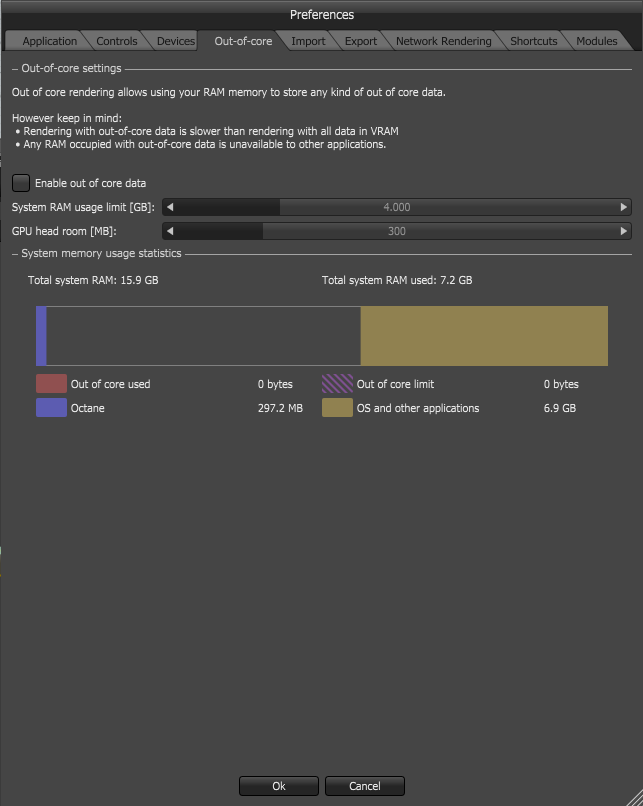

The Out-of-core feature allow users to use more textures and geometry than would fit in the graphic memory (VRAM), by keeping them in the host memory (RAM). The data for rendering the scene needs to be sent to the GPUThe GPU is responsible for displaying graphical elements on a computer display. The GPU plays a key role in the Octane rendering process as the CUDA cores are utilized during the rendering process. while rendering so some tradeoff in the rendering speed is expected. This also means that as the CPU accommodates requests to access the host memory, CPU usage will increase and any RAM occupied with out-of-core data will not be available to other applications. This holds true also for the slave nodes if OctaneRender Network RenderingThe utilization of multiple CPUs or GPUs over a network to complete the rendering process. feature is deployed. If out-of-core textures are not used, however, the rendering speed is not affected.
The Out-of-core feature comes with another restriction; Out-of-core data must be stored in non-swappable memory which is limited. So when the host memory is used up for out-of-core data, bad things will happen since the system can not make room for other processes. Since out-of-core memory is shared between GPUs, users also can not turn devices on or off while using the out-of-core feature.
Users can enable and configure the out-of-core memory system via the Application Preferences.
When using Out-Of-Core feature on slave nodes via the Octane Network Rendering Feature, enough RAM is also required for the slaves. For net render slaves, users can specify the out-of-core memory options during the installation of the daemon. When specifying this for the slaves, the out of core memory amount should be entered in bytes, not Gbytes.
For example, if the master is rendering a large scene that has texture climbing up to 6GB, the out of core memory amount to specify for the slaves during the installation of the slave daemon would look like this:
octane_slave.exe --net-master-address 192.168.xxx.xxx --net-master-port 21000 --out-of-core 6442450944
With the added support for Out of Core Geometry in Octane V4, a significant portion of the system memory may be used for geometry data. Multiple GPUs may also be utilized in conjunction with the Out Of Core feature.
The parameter below allows you to balance the level to which textures and geometry data are evicted from VRAM.
Enable Out-Of Core Data
This is a toggle to enable or disable this feature. When enabled, OOC will only ever be used when a scene does not fit the VRAM.
System RAM Usage Limit [GB]
System RAM usage limit allows you to limit how much system memory Octane will use for out of core geometry and textures. Once textures or geometry data is placed on this amount of RAM and the OOC feature kicks in, this specific memory will not be accessible by the Operating System for other tasks.
GPU Head Room [MB]
Users can specify the amount of space reserved for other GPU users. Octane maximizes the amount of memory up to the headroom limit specified here. Note that GPU memory is faster than the system memory, therefore GPU Head Room tends to be set to a minimal level since it is practical to have the maximum amount of texture and geometry data fitted into the GPU VRAM.